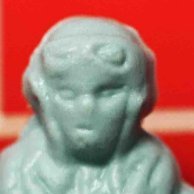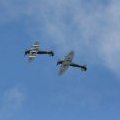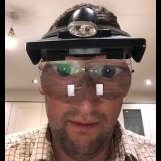Search the Community
Showing results for tags 'mk1'.
-
Some background I’m off to the Flying Legends air display at former RAF Church Fenton in sunny (here’s hoping) Yorkshire next weekend and this is responsible for spurring me back to the modelling bench after a short spring/summer break. My Daughter lives in Church Fenton about 1/2 mile from the end of the NE-SW runway and although we have bought tickets for the airfield on the Saturday, I’m staying with her and looking forward to seeing a few more flybys over her garden on Sunday, before heading off for a short break on the NE coast. I last went to an air display at Church Fenton when I was studying at Leeds University back in the late 70s through to early 80s. Despite this past familiarity I know little about the airfields history, so this time around I decided to Google whack the subject and learned that RAF Church Fenton first opened on April 1st 1937 as part of the UKs re-armament push in response to the threat of Nazi Germany's rearmament. 72 (Fighter) Squadron were posted to Church Fenton in midsummer 1937. The Squadron had reformed at RAF Tangmere on 22 February 1937 from 'B' flight of No. 1 Squadron who were then equipped with the Gloster Gladiator Mk1. Gladiator was the last bi-plane fighter to serve with the RAF and the squadron continued to fly the Gladiator from 1937 through to 1940 and didn’t in fact have them replaced by the Spitfire Mk1 monoplane fighter until around the time of Dunkirk evacuation, when the squadron moved on to RAF Acklington to take part in the Battle of Britain as part of 13 Group. It’s sobering to think that 72 Squadron Gladiator Mk1s came quite close to flying up against Bf-109Es during the summer of 1940. Whilst highly manoeuvrable, the Gladiator was almost 100 mph slower (top speed 257 mph) than the new monoplane fighters and somewhat lightly armed with 2x 0.303 Browning machine gun pods under the wings and 2x fuselage mounted synchronised Vickers machine guns firing through the propellor arc. So they would surely have been duly hacked out of the sky. With this in mind I searched for a Gloster Gladiator Mk1 kit in my favoured 1:48 scale to replicate a 72 Squadron Gladiator from Church Fenton. ICM have an excellent kit in 1/32 scale and I’ve seen several excellent builds of this on Britmodeller, but it’s a tad too big for my display space. I learned that Roden and latterly Merit produced 1/48 scale Gladiator Mk1 kits and a bit of further research indicated that the recent I 💓 Kits re-boxing of the Merit kit would be the easier build. As a bonus it also comes with 72 Squadron decals, so I paid my £25 and ordered one last week. First impressions Thus far I’ve removed all but the smallest parts from their sprues and cleaned the parts up. I’d never heard of I 💓 Kits, so for my part this was a bit of a punt. However, when it arrived I was pleasantly surprised by the quality of the moulding, which uses a hard light grey styrene. However, the complexity and level of detail provided by the kit is relatively low. Perhaps £25 might be a bit steep in retrospect, but then I was brought up in an age when similarly basic Airfix kits cost 2/6d at Woolworths. The sprue gates are a bit clunky and required a substantial clean up of their locating lugs on the parts, but there was minimal flash or burring on the parts to deal with and a few dry fit tests indicated the accuracy of fit is good overall. The basic shape looks about right, but a number of compromises have been made. The cowling is a one piece moulding (so no seams to deal with) but this results in too linear a barrel like profile. There is an aftermarket resin replacement engine and cowl available on the Hannants site, but I don't think this kit warrants the extra expense or effort, so I'll build it out the box. The cowl also has a very thick trailing edge, but judicious thinning of the inner edge with a scalpel blade should fix this. I did consider thinning the rear outer edge because this could create a more accurate curved barrel like profile for the cowl, but it would also likely ruin some of the external surface detailing, which should pop nicely with a silver finish.. There’s some internal fuselage detailing included, but with no opened canopy option and a rather thick transparency at that, it’s not likely much internal detail will be viewable when fully assembled. A quick review of the Gladiator walkaround by @Julien here on Britmodeller shows that a lot of detail is missing from the cockpit internals, such as some tubular steel framing above the control panel, a bulkhead incorporating a roll cage behind the seat and some side framing on the windscreen. I might add some seat belts, scratch build some parts and modify the canopy masking to replicate the missing details, even though I bet they will never be seen. The wings, tailplane and tail fin are all single part solid mouldings. So cutting out and positioning the control surfaces looks to be nigh on impossible. However, I might yet have a go at easing the hinge points with a scalpel, setting the rudder slightly displaced to one side and have the elevators upwardly deflected to create some additional interest. We shall see. The comments I saw about the wing and strut assembly being quite straightforward has proved to be correct. Even when assembled as a dry fit only, the wings, interplane and cabane struts align very well and it all holds together nicely. It looks like this should be a relatively straight forward build, although I’m not looking forward to replicating all that wire rigging, because I’ve never attempted a bi-plane before. Everything could fall down when I get to this. Does anyone have some guidance for this? Wish me luck!
- 31 replies
-
- 17
-

-
After my 35 years absence from modelling, a second aircraft has landed on the BoB shelf to join the fabric wing Hurricane L1592 (5 weeks ago actually, I find the modelling more compelling than the photography of same!). It's Al Deere in P9398, the Spitfire in which he had the famous 'head on' collision with Oberfeldwebel Johann Illner with both surviving the incident. A common build, sorry guys but it is a nice one for the BoB shelf. Build is OoB except for decals. Questionable Print Scale (so no starboard view) and Tech Mod technical stencils which are excellent. I found the kit lovely in areas and annoying in others. The next AF Spit from this molding will have the raised, upper wing, fixings for the .303 MG access panels instantly cut off and a slight recess drilled! I found the dihedral an issue and it had to be adapted to give the 6 degrees which is as important to the beauty of the aircraft as are it's elliptical wing surfaces. The huge WW1 trenches in front of the ailerons and flaps were filled and scribed as well as possible with my limited but growing experience. The panels lines are huge on this kit and in future I might fill and scribe them if I build again. A Tamiya 1:72 is near completion and I would rate them equally I think? (I just bought another for stash). Also a KP Mk1b is under construction. Me no like this much 🥴 (comments then when this is posted for viewing). After an email conversation with Eduard about tiny 1:44 scale resin Hurricane wheels for their lovely Hurristory 1:72 (you know the ones!), a Mk1 from them is on the way but no time scale. It is coming and it should be a delight when it lands. The Pilot is from the Hurricane kit to replace the Orc that came with the kit (see my Avatar). A bit of blue paper towel and he is ready for the 'off' in the sunny summer that 1940 provided. Big thanks to all you guys, present & lost to us, for the information provided in helping me with this build👍👌 Regards, Lindsey
- 12 replies
-
- 29
-

-
Hi all here is my Tamiya Spitfire MK1a (61119) I finished this back May/June and only just got round to posting here I decided before starting this kit that I wanted to do something different and try new things I finished it as a 19 Squadron spit serial N3200 code QV using Topnotch Cammo and insignia Masks ( a first for me ) Ive tried to replicate it as close as possible when it was lost on operations on 26th May 1940 having been shot down but not before it brought down a Junkers Ju87 Tamiya paints used throughout the build figures from Tamiya and ICM (another first in doing figures) Thanks for looking and enjoy Happy modelling Photo credit unknown
- 13 replies
-
- 45
-

-
- Spitfire
- Supermarine
-
(and 1 more)
Tagged with:
-
Hi all, While my Porsche draws closer to being completed, I have received all the parts for the VW Caddy Mk1. It consists of a C1 Models transkit VW Caddy Mk1 which utilises.... The Revell VW Golf Mk1 kit. I also intend to do a complete engine change for the VW 16V DOHC Turbo from clearlyscale. I will add a straight through metal polished exhaust as the Golf's is simply not long enough. I will also install a front mount intercooler I have in the stash from an old engine kit. The interior will be refitted with a pair of Bride bucket seats. As for the rims - I am as yet undecided but thinking along the lines of some Ronal Turbos. I think with all the modification required I am going to build it, to check how things can go together and then split it down for painting followed by a final assembly. Pictures to follow. Haven't seen many of these done so think it should be an interesting build. Cheers for stopping by, Coops.
-
Vickers Medium Tank Mk1 Trumpeter 1:35 History Despite being in general more conventional, in one aspect the Medium Mark I looked rather modern: instead of a high track run it possessed a low and flat suspension system with five bogies, each having a pair of small double wheels. The axles of these were too weakly constructed; as Major-General N.W. Duncan put it in his Medium Marks I-III: a perpetual nuisance. The axles were continually breaking and the path of the Mark I tanks was littered with discarded wheels". This was cured by switching to a "box bogie" in 1931. To ease repairs the suspension was not protected by an armoured covering. There were two vertical helical springs of unequal length in each of the five bogie casings attached to the hull. In front and behind the normal ten road wheel pairs, there was a tension wheel pair. Ground pressure was very high, even though at 11.7 tons the vehicle was not very heavy for its size. The engine was an air-cooled 90 hp Armstrong Siddeley engine derived from an aircraft type. Surprisingly the engine and transmission was distributed throughout the hull - with the engine to the left of the driver, the gearbox underneath the commander and final drive at the rear, which Duncan describes as "an unbelievable retrograde step in view of war-time experience". The Medium Mark B and the Mark VIII had introduced compartmentalisation to reduce the debilitating effects of engine noise and fumes on the crew. However with the Medium Mark I considerations of ease of maintenance took precedence. The engine drove, via a multiple dry-plate clutch, a four-speed gearbox. It had no synchromesh and switching between gears without excessive noise was a challenge to the driver. A propeller shaft connected the gearbox to a bevel box at the end of the tank which divided the power to a separate epicyclic gear for each track. These gears automatically provided extra emergency torsion to the normal first and second gear if the vehicle suddenly slowed down due to an obstacle or soft ground. The petrol tanks were at the very rear of the hull, so the fuel lines had to run along the whole length of the vehicle, pumping fuel to a secondary tank that fed the engine by gravity. The engine was lubricated and partially cooled by oil; leakage was common and the original four-gallon reservoir had to be replaced by a 13.5 gallon one. The tank could be electrically started, but only if the motor was already warm, so the first start had to be done by hand from the inside of the vehicle. Maximum speed was about 15 mph and the range about 120 miles. There was a cylindrical bevelled turret on top of the hull that carried a "Quick Firing" (shell and cartridge in one complete round) three-pounder gun (47 mm calibre) and four ball mountings for Hotchkiss machine guns. A novel, unique feature was a three-man turret. This meant that commander was not distracted with performing either the loader's or gunner's tasks and could fully concentrate on maintaining situational awareness. This gave a huge potential combat advantage, but went largely unnoticed at the time. Except for the Lago prototype, a predecessor to the Stridsvagn m/42, produced by Landsverk in 1934 no other manufacturer constructed a tank with a three-man turret until the German Panzer III. The practical importance of this feature is signified by the fact that later into the World War II, most of both sides tanks' designs either quickly switched to the three-man turret, or were abandoned as obsolete. There was no co-axial machine gun. There was only room to operate one machine gun from the turret; normally one gun was switched between the respective mountings as the guns were removable. The turret machine gunner doubled as main gun loader. In each side of the hull was a Vickers machine gun. There was one gunner to operate these weapons as well as being a mechanic. The shape of the Mark I Medium hull was very distinctive. The back was a simple armoured box; the front plate was high and perfectly vertical. Between them, from the armoured hood of the driver at the right of the vehicle six armour plates fanned out to the left, making for a complex hull geometry at that side. In the entire tank made an ungainly squat impression. The crew of five was only poorly protected by 6.25 mm plating, riveted to the chassis, barely enough to counter the threat posed by light machine guns. With its many shot traps the vehicle was unable to withstand even anti-tank rifle fire and it had a high profile. The internal lay-out worsened this vulnerability as the petrol tanks were inside the main compartment The Model It’s great to see an British interwar tank being released at last, and hopefully it’ll be the first of many. The kit comes in the now standard style of top opening box, with a nice depiction of the tank trundling along a country track. Inside you get eight sprues and two separate parts in the beige styrene favoured by Hobbyboss, four sprues of brown styrene, a medium sized etched sheet and a decal sheet. All the parts are very well moulded, there is no sign of flash or other imperfections, but you do get quite a few moulding pips that’ll mean a bit more cleaning up of parts. The moulded detail is nicely done, including the fairly prominent rivets on the turret and slab sided hull. The individual track links look like they’ll cause the build to slow down quite a bit as each link has three sprue gates to clean up, as well as each of the separate track pads, which have two gates each. Care and patience will be the watchwords when assembling. Construction begins with the assembly of the multitude of wheels, fortunately each of the small wheels are moulded as a single piece. There are two pairs on single short struts, two on long struts and ten quad bogies, each made up of ten parts. Each wheel assembly is then fitted into the track sponsons with the suspension plates attached to the top of each strut. The idler wheel axles are then fitted to each sponson, to which the six piece idlers are attached, then sandwiched with an outer panel. The side mounted Vickers machine guns are now built up, and whilst they are quite well detailed, each being made up from six parts, it’s all a bit of a waste as you won’t see any of it once they are fitted. The guns are fitted into the two piece ball, which in turn sandwiched between the outer panel and in internal socket. The lower hull is fitted out with the bottom panel, two sprocket axle plates, rear mounted door and four side hatches, along with the machine gun assemblies. Each sprocket is built up from six parts before being glued into place, along with the rear door step, several grab handles, a top mounted panel and a panel above each machine gun. There are two intake vents, a large square one that fits to the front of the hull and a round one fitted just in front of the engine grille, there is also a oblong hatch fitted to the right side front hull. Two further panels are attached to the hull, one just aft of the engine deck, the other in front of the turret ring. The two track sponsons are now glued to each side of the hull, along with a flat plate that attaches to the front glacis plate. The modeller has the option of two different styles of return rollers to fit, some research will be required to work out which was fitted to the specific being modelled. Each roller is made up from two wheels and a separate axle, before being attached to the hull, four per side. The rear section of the drivers hatch is also fitted at this point. A tie rod is then attached across the return roller axles and the rounded sides of the drivers position are glued into position and topped off with the hatch. The tracks are now assembled, each side requiring sixty five links. The track guards are then attached to the hull, with the port side one being fitted with the two piece exhaust pipe. The hull is then fitted with a host of PE track guard brackets, whilst the two four piece headlights are assembled, again with the option of two different styles, and fitted to the fronts of each guard. The upper turret comes as a single piece moulding and is fitted with two rear mounted hatches, five viewing ports, and the trunnion mount, to which the main gun barrel and underslung recouperator are fitted. The turret ring is fitted, along with the commanders and front mounted hatches. The model is finished off with the fitting of the turret and prominent headlight protectors to the hull. There is a slight disparity between the instructions and the painting guide, in that the guide shows the turret mounted Lewis gun fitted, and the gun is supplied in the kit, but there is no mention of how to fit it, even though there is a ball socket style lump on the rear of the turret roof showing its position. Decals Whilst the decal sheet isn’t the smallest I’ve come across, there are in fact very few decals on it. In fact one of the two options only has the front and rear number plates. The other option has these, as well as a unit and tanks codes for the turret, hull sides and rear hull, all in white, but no reference to which unit it belonged to in the notes. Both vehicles are painted in the camouflage colour of the day of Olive Drab. Conclusion This will be a great addition to any AFV modellers collection, beginning to bridge the gap between the Rhomboid WW1 tanks and the more modern tanks leading up to WW11. Apart from the fiddly track links, the rest of the kit looks like it should go together without too many problems. Very highly recommended. Review sample courtesy of
- 5 replies
-
- Creative Models
- Vickers
-
(and 2 more)
Tagged with:
-
After building two mkVs I thought I would do something different, but one of the kids bought me the 1/24 Airfix Mk1 for xmas, so after two weeks of tinkering here is what I have on the desk. I'd be interested in tips on this one - when it's finished it'll be hanging from the ceiling with wheels up, I notice they appear to be retractable, but I'm dubious about the alignment. Oh, and this is the first time I've tried posting from Flickr... 1/24 airfix spitfire Mk1 by Andy Moore, on Flickr
-
Hi everyone Well another day and another build. My 1/32 has been put to one side for a little while for no other reason than I received the Airfix Albion 3 point refueller and Bedford MWD plus the WW2 RAF ground crew set. For a long time I've wanted to create a typical scene that happened on any given day at every RAF fighter station during the opening days of WW2. I wont be using all of the above items but I intend to create a diorama for the Spitfire and another for the Hurricane. I've also bought decals from Xtradecal (X48086 RAF Battle of Britain 50th anniversary Spitfires and Hurricanes) and the Spitfire will be finished as R6800 for no other reason that I like the Sky Blue undersides and the Roundel red spinner. I started the Airfix kit about 2 -3 months ago but it stalled because in my example part C51 was in three pieces but after an email the good folks at Airfix sent a replacement. So here is where I'm at the cockpit is complete and the fuselage has been glued together.. I hope to crack on with this over the next few weeks as I'm iching to start on the ground equipment, which by the way I have no knowledge on! Cheers Iain
-
Well I decided to start a new project. Photo's to follow. 'Sailor' Malan's Spitfire that he flew with 74 Squadron in 1940, ZP-A (K9953). I am hoping to record the progress of this build, unlike my last project (DB Airfix Spit) which I have put to one side. It just seemed to keep going wrong. Perhaps every Spitfire project starts with a bit of debate, so here goes. I have Southern Expo 70th Anniversary decal sheet which shows a Sky Blue. Now we all know that the Stadard 1940 Scheme started of as Black/White and the went to Type S (Tamiya XF-21). I am cuirious as to the correct underside colour for Malan's Spit. I am sure a lively debate will follow as I prep the first set of photos.
- 15 replies
-
- Sailor Malan
- Spitfire
- (and 5 more)
-
I started this as a thread in Work in progress. I am suprised that our usual Guru's haven't come to the fore. So I am do "repost" in the discussion section in the hope that it involes some reponse. ..Sailor' Malan's Spitfire that he flew with 74 Squadron in 1940, ZP-A (K9953)...I have Southern Expo 70th Anniversary decal sheet which shows a Sky Blue. Now we all know that the Stadard 1940 Scheme started of as Black/White and the went to Type S (Tamiya XF-21). What is the correct underside colour for Malan's Spit? Hope to hear some replies soon Regards Sean







